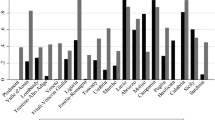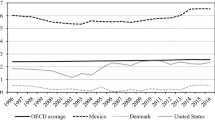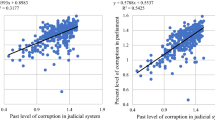Abstract
This article is the first to statistically examine the reciprocal relationship between formal political institutions and political corruption. We argue that political corruption is an informal institution that allows nondemocratic leaders to build political support, act as a substitute for liberalizing concessions in the formal institutions of the state, and thereby extends the longevity of non-democratic regimes. Yet, whereas high corruption level will prevail in nondemocratic regimes, we expect the electoral constituency in democratic regimes to have the formal power to curb political corruption. We demonstrate that these expectations hold by estimating a dynamic multinomial regression model on data for 133 countries for the 1985–2008 period. Our model shows that high-corruption autocracies and hybrid regimes are more stable than their low-corruption counterparts, but that low-corruption democracies are more stable than high-corruption ones. For autocratic and hybrid regimes, the stability is due both to corruption making the formal institutions more resistant to democratization and that the formal institutions prevent reductions in corruption. Consistent democracies, on the other hand, are able to reduce corruption and become more stable as a result.




Similar content being viewed by others
Notes
Our classifications of democratic, authoritarian, and hybrid regimes are based on the SIP measure of democracy (Gates et al. 2006). The measure ranges from 0 (full autocracy) to 1 (full democracy), and the cutoff points for hybrid regime and democracy are set at 0.15 and 0.80, respectively. The Polity project shows the same trends (see http://www.systemicpeace.org/polity/polity4.htm).
Some of this increase in perceived corruption may reflect that the International Country Risk Guide (ICRG) now set higher standards for how public affairs are to be conducted than in the 1980s, but the figure still indicates no corruption-reducing effect of democracy at the global level.
See also Grzymala-Busse (2010).
The term clientelism is sometimes discussed as distinct from the phenomenon of political corruption by being explicitly confined to the electoral arena and involving a broader distribution of rents. Many researchers, however, see political corruption and rent seeking as an integral part of the concept of clientelism (see, for example, Kitschelt 2000; Keefer 2007; Bratton 2007).
Scholars have proposed a range of labels for hybrid regimes, including “inconsistent,” “semidemocracy,” “electoral authoritarianism,” or “semi-authoritarianism.” We use the label hybrid regimes from Levitsky and Way (2002)and Diamond (2002). Most of the hybrid regimes in our sample are electoral authoritarian systems, but some display another mix of democratic and autocratic traits, for example, combining strong democratic institutions with severe restrictions on suffrage. We expand on our discussion of these regime categories below.
Indeed, a large political base dilutes the value of the tangible reward for each client and, in turn, reduces the recipient’s obligations to support the leader.
The dataset is available at http://havardhegre.net/replication-data/.
Changes to political institutions often take time and are associated with a period of turmoil. The Polity project codes these transition periods with a set of transition codes (−77, −88, −99). Such periods may last for several years. To take such transitions into account when observing countries annually, we replace transition codes with the regime type observed immediately before the transition.
We have data at a finer temporal resolution than the year for both the corruption (quarterly series) and democracy indicators (in principle, daily series). We assign the value of the last observation within the year as the annual observation.
For more information about the data and coding, see www.icrgonline.com. The data are available from www.countrydata.com.
The transition probability corresponding to cell j,i is the column proportions, or the probability of observing a state j at t given that a country was in state j at t − 1.
The steady-state probabilities or the “stationary probability distribution” is the distribution across the six outcomes that emerge if the transition probability matrix is repeated many times. As such, it accounts for how all possible transitions affect this distribution. It can be generated by multiplying the matrix of transition probabilities with itself a high number of times. The steady-state distribution can also be obtained by solving a system of linear equations; see Taylor and Karlin (1998, p. 247).
The multinomial logit model with six categories for the dependent variable requires the estimation of a large number of parameters. We refrain from including additional variables to avoid over-fitting of the model. We have also estimated a model with a set of region dummies, reported briefly in Appendix A.2.
The estimate of −2.055 for “oil” in the equation for low-corruption democracy (equation 5), for instance, means that the odds for oil economies of being in the low-corruption democracy state relative to the reference outcome is exp(−2.055) = 0.12 times that of nonoil economies. Or, nonoil economies are about eight times more likely to be low-corruption democracies than the reference outcome. Given the constraints on the model, the reference outcome in this case is either high-corruption autocracy, high-corruption hybrid, or low-corruption autocracy.
We set parameters for control variables to 0 if they were not significant at the 10 % level, and parameters for lagged dependent variables to zero if their p values were higher than 0.50.
We used a random-number generator to change one arbitrarily selected country-year observation to a transition from low-corruption inconsistent to high-corruption autocracy and one from low-corruption democracy to high-corruption autocracy. These two artificial observations adds unbiased noise to the estimation, but allows the estimation of two parameters modeling the log odds of “empty-cell transitions.” All other parameters estimating the log odds of empty-cell transitions were constrained to be equal to these, so that the estimates reflect the “average” log odds of such transitions. The large negative estimate we obtain is a good approximation to the low-probability event of changing corruption level and regime type in the same year. Without this adjustment, the parameters corresponding to empty cells are estimated to be very large negative numbers, corresponding to relative risks approaching zero, with very large standard errors. The presence of such poorly defined estimates also hurt the precision of other parameters in the model.
For autocracies, the mean difference was 0.041, the standard deviation 0.027, the t value 1.54, and the one-sided p value 0.062.
These conclusions are not restricted to our “typical case,” a middle-income nonoil economy. Appendix Tables 6 and 7 report the same tests for low-income and oil-producing countries. We obtain very similar results for autocracies and hybrid regimes for all four combinations of income level and oil. The only exception is that low-income or oil-producing high-corruption democracies are more stable than their low-corruption counterparts.
Table 1 shows that there are many more observations of transitions underlying these probabilities—e.g., 18 from low-corruption to high-corruption autocracy and 47 from low-corruption to high-corruption democracy.
References
Acemoglu D, Robinson JA. De facto political power and institutional persistence. AEA Papers and Proceedings. 2006a;May(2):325–330. Available at http://ideas.repec.org/a/aea/aecrev/v96y2006i2p325-330.html.
Acemoglu D, Robinson JA. Economic origins of dictatorship and democracy. New York: Cambridge University Press; 2006b.
Acemoglu D, Robinson JA, Verdier T. Kleptocracy and divide and rule: a model of personal rule. J Eur Econ Assoc. 2004;2(2–3):162–92.
Adzera A, Boix C, Payne M. Are you being served? Political accountability and quality of government. J Law Econ Org. 2003;19(2):445–90.
Arriola LR. Patronage and political stability in Africa. Comp Polit Stud. 2009;42(10):1139–362.
Bates RH. States and markets in tropical Africa: the political basis of agricultural policy. Series on social choice and political economy. Berkeley: University of California Press; 1981.
Bayart JF. The state in Africa: the politics of the belly. New York: Longman; 1993.
Bratton M. Formal versus informal institutions in Africa. J Democr. 2007;18(3):96–110.
Bratton M, Van de Walle N. Neopatrimonial regimes and political transitions in Africa. World Polit. 1994;46(July):453–89.
Bueno de Mesquita B, Smith A, Siverson RM, Morrow JD. The logic of political survival. Cambridge: MIT Press; 2003.
Chabal P, Daloz J-P. Africa works: disorder as political instrument. Oxford: James Currey; 1999.
Dahl R. Democracy and its critics. New Haven: Yale University Press; 1989.
Dahl M, Gates S, Hegre H, Strand H. Why waves? Global patterns of democratization, 1820–2008. Typescript, PRIO; 2014. Available at http://havardhegre.net/items/whywaves/.
Darden K. The integrity of corrupt states: graft as an informal state institution. Polit Soc. 2008;36(1):35–60.
Diamond L. Thinking about hybrid regimes. J Democr. 2002;13(2):21–35.
Eckstein H. Authority patterns: a structural pattern for inquiry. Am Polit Sci Rev. 1973;67(4):1142–61.
Englebert P. Pre-colonial institutions and post-colonial states and economic development in tropical Africa. Polit Res Q. 2000;53(7):7–36.
Epstein DL, Bates R, Goldstone J, Kristensen I, O’Halloran S. Democratic transitions. Am J Polit Sci. 2006;50(3):551–69.
Fearon JD, Laitin DD. Ethnicity, insurgency, and civil war. Am Polit Sci Rev. 2003;97(1):75–90.
Gandhi J, Przeworski A. Cooperation, co-optation and rebellion under dictatorships. Econ Polit. 2006;18(1):1–26.
Gates S, Hegre H, Jones MP, Strand H. Institutional inconsistency and political instability: polity duration, 1800–2000. Am J Polit Sci. 2006;50(4):893–908.
Gerring J, Thacker SC. Political institutions and corruption: the role of unitarism and parliamentarism. Br J Polit Sci. 2004;34:295–330.
Gleditsch KS. Expanded trade and GDP data. J Confl Resolut. 2002;46(5):712–24.
Grafton RQ, Rowlands D. Development impeding institutions: the political economy of Haiti. Can J Dev Stud. 1996;XVII(2):261–77.
Grzymala-Busse A. The best laid plans: the impact of informal rules on formal institutions in transitional regimes. Stud Comp Int Dev. 2010;45(3):311–33.
Gurr TR. Persistance and change in political systems, 1800–1971. Am Polit Sci Rev. 1974;68(4):1482–504.
Helmke G, Levitsky S. Informal institutions and comparative politics: a research agenda. Perspect Polit. 2004;2(4):725–40.
Helmke G, Levitsky S. Informal institutions and democracy. Baltimore: Johns Hopkins University Press; 2006.
Huntington SP. Political order in changing societies. New Haven: Yale University Press; 1968.
Huntington SP. The third wave: democratization in the late twentieth century. Norman: University of Oklahoma Press; 1991.
Hyden G. African politics in comparative perspective. New York: Cambridge University Press; 2006.
Jaggers K, Gurr TR. Transitions to democracy: tracking democracy’s third wave with the Polity III data. J Peace Res. 1995;32(4):469–82.
Johnston M. The political consequences of corruption. A reassessment. Comp Polit. 1986;18(4):459–77.
Johnston M. Syndromes of corruption: wealth, power, and democracy. Cambridge: Cambridge University Press; 2005.
Keefer P. Clientelism, credibility, and the polity choices of young democracies. Am J Polit Sci. 2007;51(4):804–21.
King G, Tomz M, Wittenberg J. Making the most of statistical analyses: improving interpretation and presentation. Am J Polit Sci. 2000;44(2):347–61.
Kitschelt H. Linkages between citizens and politicians in democratic politics. Comp Polit Stud. 2000;33(6–7):845–79.
La Porta R, Lopez-de Silanes F, Shleifer A, Vishny R. The quality of government. J Law Econ Org. 1999;15(1):222–79.
Lauth H-J. Informal institutions and democracy. Democratization. 2000;7(4):21–50.
Lederman D, Loayza NV, Soares RR. Accountability and corruption: political institutions matter. Econ Polit. 2005;17(1):1–35.
Lemarchand R. Political clientelism and ethnicity in tropical Africa: competing solidarities in nation-building. Am Polit Sci Rev. 1972;66(1):68–90.
Levitsky S, Way LA. The rise of competitive authoritarianism. J Democr. 2002;13(2):52–65.
Levitsky S, Way LA. Competitive authoritarianism. Hybrid regimes after the Cold War. Cambridge: Cambridge University Press; 2010.
Maddison A. Contours of the world economy 1–2030. Essays in macroeconomic history. Oxford: Oxford University Press; 2007.
Manzetti L, Wilson CJ. Why do corrupt government maintain public support. Comp Polit Stud. 2007;40(August):949–70.
Medina LF, Stokes S. Clientelism as political monopoly. Unpublished manuscript. 2002.
Montinola GR, Jackman R. Sources of corruption: a cross-country study. Br J Polit Sci. 2002;32:142–70.
Nyblade B, Reed SR. Whoe cheats? Who loots? Political competition and corruption in Japan, 1947–1993. Am J Polit Sci. 2008;52(4):926–41.
O’Donnell G. Another institutionalization: Latin America and elsewhere. Kelllogg Institute Working paper No. 222. 1996.
O’Donnell G, Schmitter P, Whitehead L. Transitions from authoritarian rule. Baltimore: Johns Hopkins University Press; 1986.
Persson T, Tabellini G, Trebbi F. Electoral rules and corruption. J Eur Econ Assoc. 2003;1(4):958–89.
PRS Group. International country risk guide: the political risk rating. East Syracuse: PRS Group; 2006.
Przeworski A. Democracy and the market: political and economic reforms in Eastern Europe and Latin America. Cambridge: Cambridge University Press; 1991.
Przeworski A, Alvarez ME, Cheibub JA, Limongi F. Democracy and development. Political institutions and well-being in the world, 1950–1990. Cambridge: Cambridge University Press; 2000.
Robinson JA, Verdier T. The political economy of clientelism. CEPR Working Paper 3205, February. 2002.
Rose-Ackerman S. Corruption. A study in political economy. New York: Academic; 1978.
Rose-Ackerman S. Corruption and government: causes, consequences and reform. Cambridge, United Kingdom: Cambridge University Press; 1999.
Ross M. Does oil hinder democracy. World Polit. 2001;53(April):325–61.
Sanhueza R. The hazard rate of political regimes. Public Choice. 1999;98:337–67.
Schedler A. The menu of manipulation. J Democr. 2002;13(2):36–50.
Schedler A. The logic of electoral authoritarianism. In: Schedler, editor. Electoral authoritarianism: the dynamics of unfree competition. Boulder: Lynne Rienner Publishers; 2006.
Shleifer A, Vishny RW. Corruption. Q J Econ. 1993;108(August):599–617.
Smith IO. Election boycotts and hybrid regime survival. Comp Polit Stud. 2014;47(5):743–765.
Tavits M. Clarity of responsibility and corruption. Am J Polit Sci. 2007;51(1):218–29.
Taylor HM, Karlin S. An introduction to stochastic modeling. 3rd ed. Academic Press: San Diego; 1998.
Thompson MR, Kuntz P. After defeat: when do rulers steal elections? In: Electoral authoritarianism. Colorado: Lynne Rienner Publishers; 2006. p. 113–28.
Treisman D. The causes of corruption: a cross national study. J Public Econ. 2000;76(3):399–457.
Treisman D. What have we learned about the causes of corruption from ten years of cross-national empirical research. Annu Rev Polit Sci. 2007;10:211–44.
Vanhanen T. A new dataset for measuring democracy, 1810–1998. J Peace Res. 2000;37(2):251–65.
Warren ME. What does corruption mean in a democracy? Am J Polit Sci. 2004;48(2):328–43.
Weingast BR. The political foundations of democracy and the rule of law. Am Polit Sci Rev. 1997;91(2):245–63.
Wintrobe R. The tinpot and the totalitarian: an economic theory of dictatorship. Am Polit Sci Rev. 1990;84(3):849–72.
Wintrobe R. The political economy of dictatorship. Cambridge: Cambridge University Press; 1998.
World Bank. World development indicators. Washington, DC: World Bank; 2011.
Author information
Authors and Affiliations
Corresponding author
Appendix
Appendix
Graphs of Steady-State Distributions
Additional Regression Results
Estimated Transition Matrices
Rights and permissions
About this article
Cite this article
Fjelde, H., Hegre, H. Political Corruption and Institutional Stability. St Comp Int Dev 49, 267–299 (2014). https://doi.org/10.1007/s12116-014-9155-1
Published:
Issue Date:
DOI: https://doi.org/10.1007/s12116-014-9155-1







